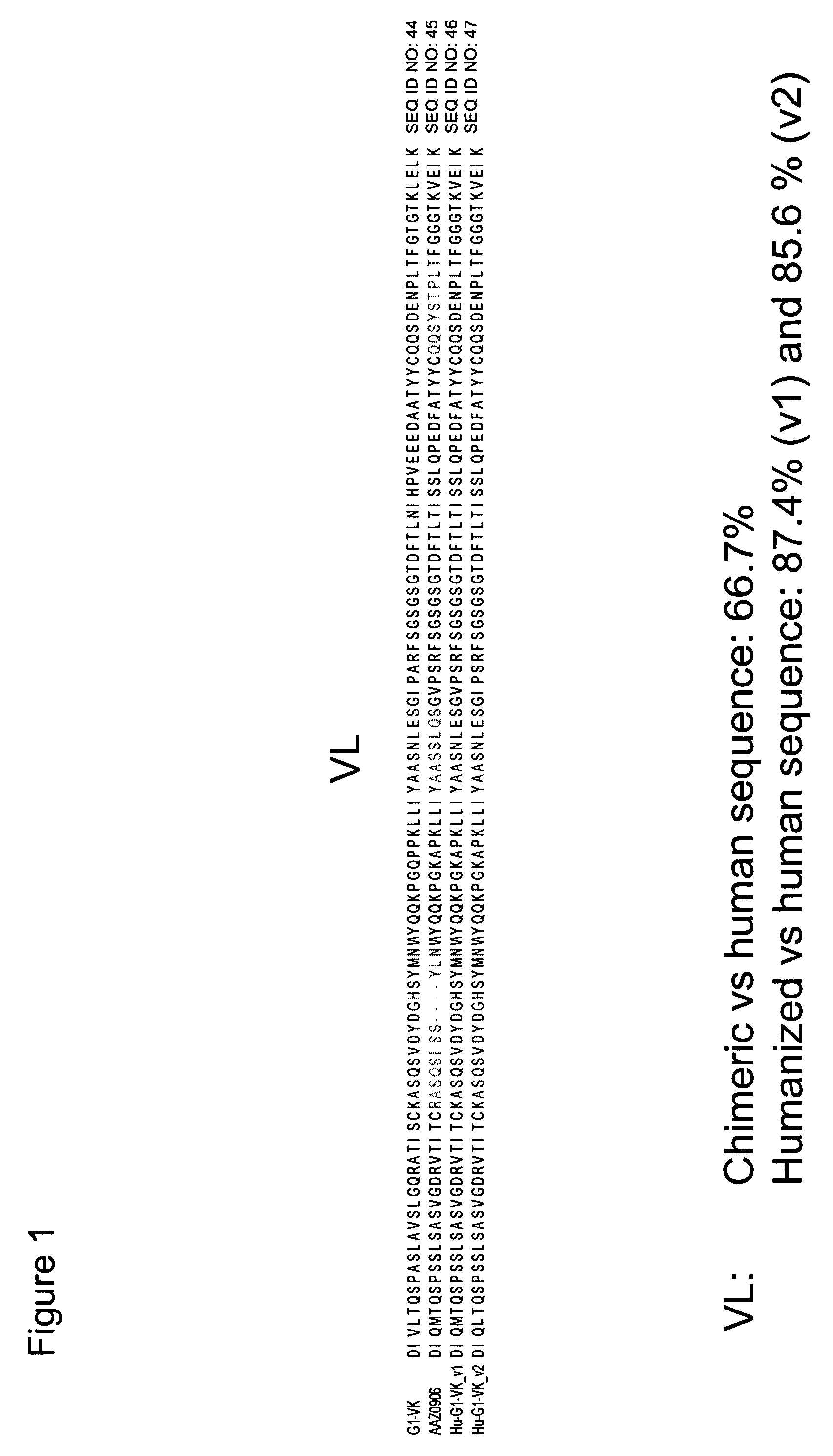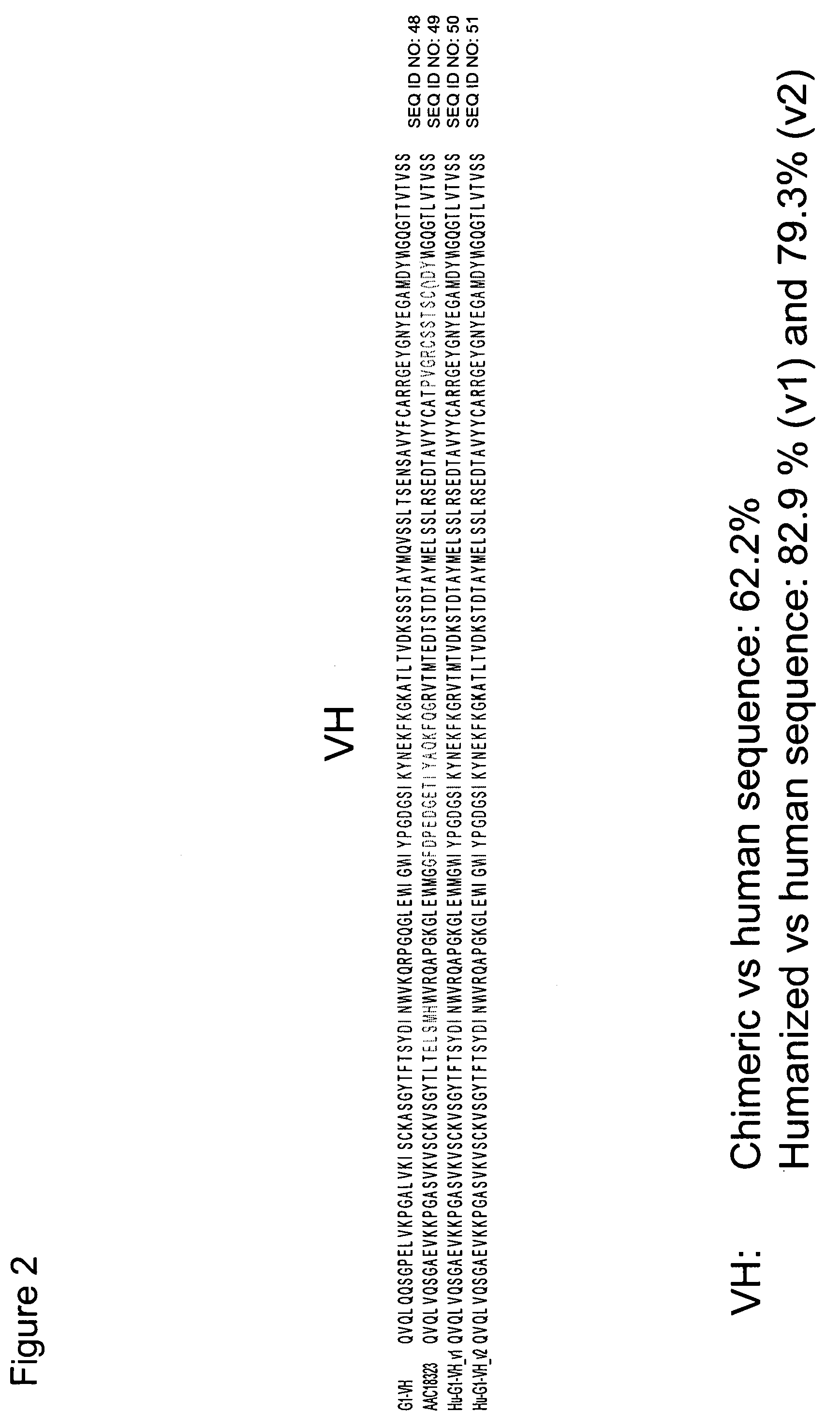Anti-P-selectin antibodies and methods of using the same to treat inflammatory diseases
a technology of p-selectin and antibodies, applied in the field of antibodies, can solve the problems of progressive multi-organ dysfunction and premature death, increased pain and repeated hospitalization of patients, and increased vasoocclusive complications, so as to increase the affinity of antibodies and no effect on antigen binding
- Summary
- Abstract
- Description
- Claims
- Application Information
AI Technical Summary
Problems solved by technology
Method used
Image
Examples
example 1
Preparation of Chimeric or Humanized Antibodies of the Invention
[0095]Anti-P-selectin antibodies of the invention can be prepared by replacing one or more of the CDRs of a human antibody sequence with the CDRs from murine mAb G1. Alternatively, all or a part of the heavy and light chain variable regions from the murine mAb G1 can be used to replace the corresponding sequence in a human FR immunoglobulin. The light chain CDR sequences of the murine mAb G1 are set forth in SEQ ID NOs: 1-3, while the heavy chain CDR sequences of the murine mAb G1 are set forth in SEQ ID NOs: 4-6.
[0096]To design the Fv region of the humanized antibody which includes a light chain variable region VL and a heavy chain variable region VH, the human VL and VH sequences that are frequently expressed in the human body and that have a significant sequence identity with the mouse VL and VH sequences respectively are first identified. The human VL sequence indicated by Genbank Accession No. AAZ09096 and the huma...
example 2
Cloning of Murine Antibody
[0097]mRNA was extracted from the hybridoma cell pellets, and agarose gel analysis showed a high yield of the extracted RNA from the pellet. cDNA was created from the RNA by reverse-transcription with an oligo(dT) primer. PCR reactions using variable domain degenerate primers to amplify the VH and VL regions of the monoclonal antibody DNA gave the bands shown in FIG. 3. The purified VH and VL PCR products from RT-PCR were cloned into a sequencing vector and positive transformants were determined by colony PCR. From the RT-PCR, 6 VL and 6 VH clones were identified and the DNA was sequenced. The amino acid sequence was derived from the sequence of the DNA open reading frame. There was a single consensus sequence for both the variable light chain and the variable heavy chain (see Tables 1 and 2).
[0098]
TABLE 1CDR sequences from murine mAb G1Amino Acid SequencesVL CDR1:KASQSVDYDGHSYMN (SEQ ID NO: 1)VL CDR2:AASNLES (SEQ ID NO: 2)VL CDR3:QQSDENPLT. (SEQ ID NO: 3)V...
example 3
Sequences for the Humanized P-Selectin Immunoglobulin Based on G1
Nucleotide Sequences for Hu-G1
[0104]V1 and V2 (shown below) refer to the “aggressive” (i.e., more human) and “conservative” (i.e., more murine) versions of the humanized antibody amino acid sequences, respectively. For each of those, the “A” codons were generated by starting with those of the human framework sequences and the codons of the mouse CDR sequences, then changing codons as needed to match the actual humanized amino acid sequence. The “B” codons started with the mouse codons and then changed where needed to match the humanized amino acid sequences.
[0105]
V1-aggressive (No.V2-conservative (No.Chainmouse frm.)mouse frm.)VK02VH48
[0106]
Light chain:Hu-G1-VK_v1_nuc-AHu-G1-VK_v1_nuc-BHu-G1-VK_v2_nuc-AHu-G1-VK_v2_nuc-BHeavy chain:Hu-G1-VH_v1_nuc-AHu-G1-VH_v1_nuc-BHu-G1-VH_v2_nuc-AHu-G1-VH_v2_nuc-B
CDR amino acids are indicated in italics and in bold; mouse framework substitutions are marked in bold and underlined. The ...
PUM
| Property | Measurement | Unit |
|---|---|---|
| dissociation constant | aaaaa | aaaaa |
| dissociation constant | aaaaa | aaaaa |
| dissociation constant | aaaaa | aaaaa |
Abstract
Description
Claims
Application Information
 Login to View More
Login to View More - R&D
- Intellectual Property
- Life Sciences
- Materials
- Tech Scout
- Unparalleled Data Quality
- Higher Quality Content
- 60% Fewer Hallucinations
Browse by: Latest US Patents, China's latest patents, Technical Efficacy Thesaurus, Application Domain, Technology Topic, Popular Technical Reports.
© 2025 PatSnap. All rights reserved.Legal|Privacy policy|Modern Slavery Act Transparency Statement|Sitemap|About US| Contact US: help@patsnap.com



